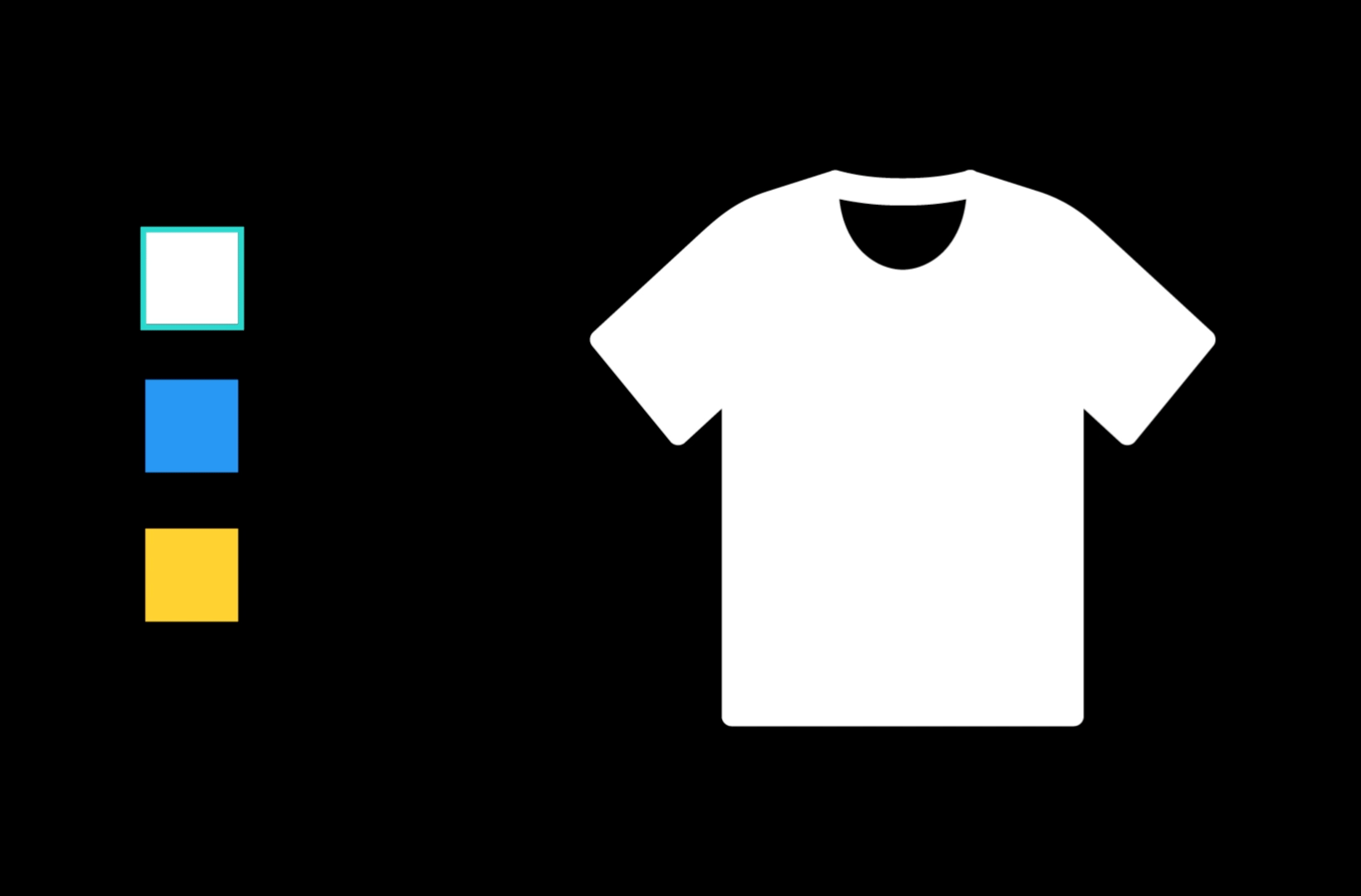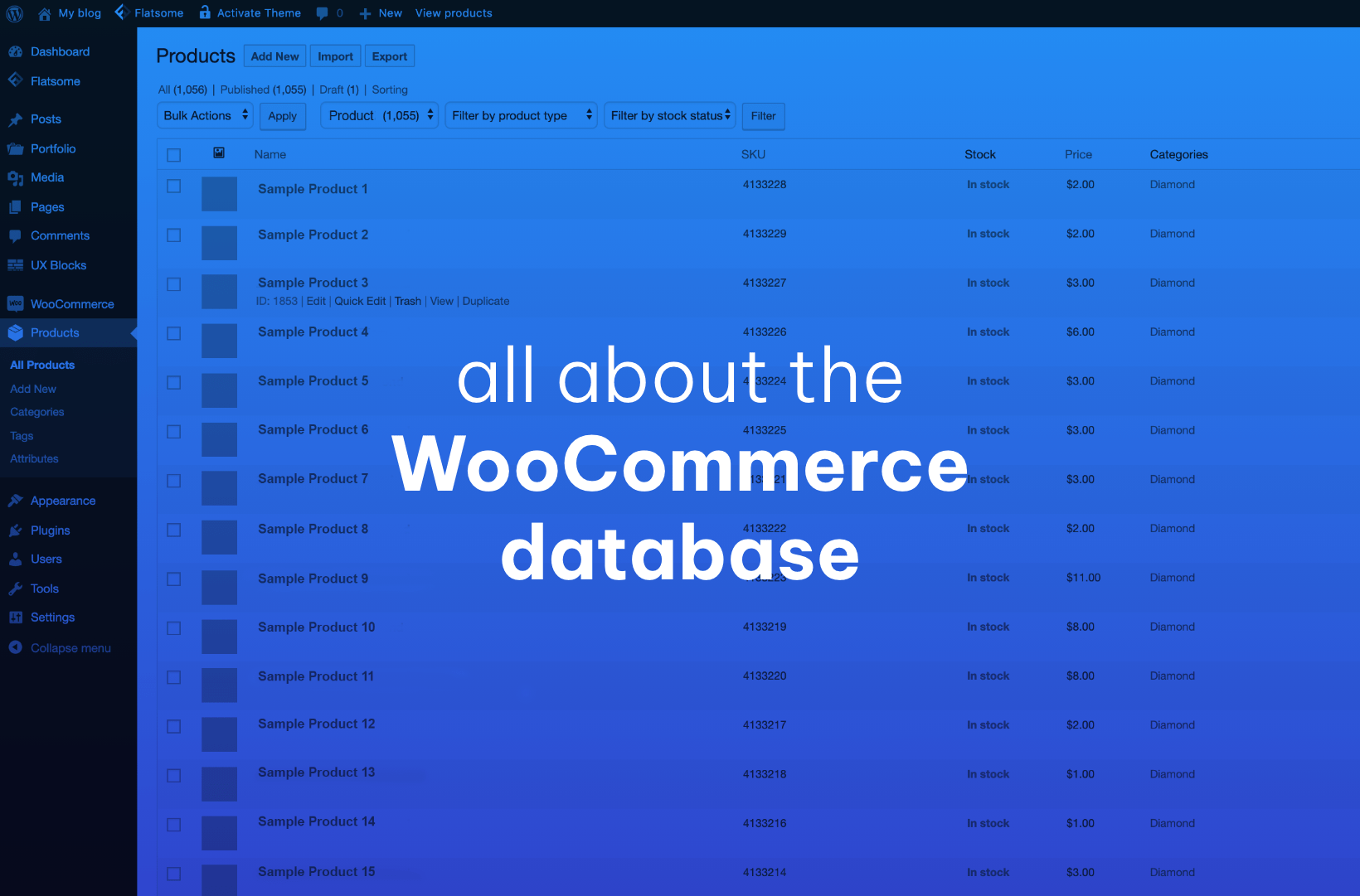Imagine a customer landing on your online store, finding the perfect product, but realizing they can’t tweak it to suit their unique needs or preferences. Frustrated, they might abandon their cart and look elsewhere!
In a world where customization is not just nice to have but is a necessity, customizable products are an invaluable component of tailoring the customer experience.
When customers have the power to modify products according to their desires, it can lead to heightened customer satisfaction and loyalty, which in turn, drives revenue through repeat purchases and word-of-mouth referrals.
But, how can one harness the potential of customizable products in WooCommerce?
Well, that’s what this guide is for! Whether you’re a seasoned online store owner or just dipping your toes into the waters of eCommerce, understanding how to build customizable products in WooCommerce is essential.
With 77% of consumers choosing, recommending, and paying more for a brand that personalizes product offers, it’s evident that store owners need to be hungry for insights and strategies to ride this wave of customization.
Let’s unshackle the power of customization in your WooCommerce store together, and craft an eCommerce experience that is as unique as each of your customers. Keep reading for the tools and insights that will turn your WooCommerce store into a hub of customization and customer delight!
Benefits of offering personalized WooCommerce products
Customizable products allow customers to make modifications or add personalized elements, such as text, product images, or design choices. This customization can range from simple variations in color and size to complex configurations tailored to the customer’s specifications.
A survey conducted by Google found that a staggering 9 out of 10 top marketers believe that personalization significantly contributes to profitability. This is not surprising, as offering personalized products is intrinsically linked to delivering a superior customer experience.
Personalized products play an important role in eCommerce, as they lead to:
- Improved customer engagement: When customers are given the freedom to tweak products to their liking, they tend to engage more with the brand. This interaction often translates into longer site visits and more meaningful interactions with the content. It can also lead to a higher average order value compared to standard products.
- Boosted sales and conversion rates: Personalized products can often be the deciding factor in a consumer’s purchase decision. When customers find products that resonate with their personal tastes and preferences, they are more likely to make a purchase.
- Enhanced customer loyalty: Offering customizable products often leads to customers feeling a deeper connection to the brand. This elevated relationship with the brand is likely to lead to repeat purchases and a higher likelihood of the customer becoming a brand ambassador through word-of-mouth referrals.
- Reduced customer churn: When your product range caters to a diverse set of preferences, customers are less likely to seek alternatives, reducing the churn rate significantly.
- Insight into customer behavior: Customization options allow you to gather data on customer preferences, which can be invaluable for tailoring your future product offerings and marketing strategies.
- Creating a competitive edge: In a market saturated with similar products, customization can be the differentiator that sets your WooCommerce store apart from the rest. Customizable products not only differentiate your store but also attract a broader audience looking for unique offerings.
Why use a product designer plugin?
For WordPress store owners looking to venture into the world of customizable products, using a product designer plugin is not just an option, but a necessity. This is primarily because WooCommerce, as powerful as it is, doesn’t have the native functionality to allow for intricate product customization.
Let’s explore the reasons that make employing a product designer plugin an essential step in enabling product customization on your eCommerce store.
Straightforward setup and ease of use
One of the most compelling reasons to use a product designer plugin is the level of convenience and user-friendliness they provide. As these plugins are designed to work in tandem with WooCommerce, they enable you to start creating customizable products effortlessly within minutes of installation.
A powerful product designer plugin with an intuitive interface offers complete ease of use in creating and managing personalized products, which in turn saves the time and effort required for custom development.
Managing complex design processes
Customizing products isn’t always as simple as choosing a color or size. Some products may require complex design processes that are virtually impossible to manage manually. A product designer plugin significantly simplifies this process. It presents customers with an intuitive interface where they can design, alter, and visualize their custom products in real time.
This not only enhances the user experience but also minimizes errors and customer dissatisfaction due to miscommunication or misunderstanding of customization options.
Adding custom product fields to your store
An added advantage of using a product designer plugin is the ability to integrate various custom fields into your store. With an add-on plugin, you can implement checkboxes, radio buttons, text fields, file uploads, and other value types that facilitate the customization process.
Such a wide array of custom fields is essential in helping your customers craft their perfect products by offering them more control and options.
Allowing customers to choose between custom options
Custom fields in a product designer plugin enhance customer experience significantly, especially if the plugin has an intuitive user interface. They enable customers to make custom selections regarding various aspects of the product, such as color, size, material, features, personalization options, and packaging, with ease.
This level of customization lets customers have a more engaging and personalized shopping experience and create products that resonate with their personal tastes and preferences.
Developing a product strategy for customizable offerings
When embarking on the path of offering customizable products in your WooCommerce store, having a clear and well-defined product strategy is paramount. A product strategy serves as the roadmap that guides your customizable product offerings, ensuring that they are in alignment with both customer demand and your business objectives.
Additionally, a robust product strategy enables you to make informed decisions regarding your product offerings and marketing efforts, ensuring that resources are allocated effectively and efficiently.
Here are some steps for developing an efficient and effective product strategy:
Define target audiences
Before diving into customizable product offerings, it is crucial to know who your target audience is. Understanding who is most likely to be interested in and benefit from your customizable products will allow you to tailor your offerings to meet their specific needs and preferences.
Here are some steps you can take to identify target audiences:
- Market research: Conduct market research to understand trends and demands in the industry. Use tools such as surveys, focus groups, and online analytics to gather data on customer preferences and behaviors.
- Analyze existing customer data: Leverage the data you already have on your current customers. Analyze purchasing patterns, feedback, and customer profiles to gain insights into what types of customization options might be in demand.
- Identify customer segments with high demand for personalized products: Based on your market research and customer data analysis, identify customer segments that show a strong inclination towards personalized products. This might include demographics such as age groups, geographical locations, or specific interests and hobbies.
Define core offerings
Once you have identified your target audience, it is imperative to define the core offerings of your customizable products. This involves:
- Identifying types of customization options to offer: Evaluate what types of customization options are feasible for your business and are in demand by your target audience. This could include color variations, engraving, custom prints, and more.
- Ensuring alignment with target audience preferences and needs: Make sure that the customization options you offer resonate with the preferences and needs of your target audience. This might involve tailoring certain aspects of the customization options to cater to specific demographics.
- Balancing customization with operational feasibility and profitability: While customization is valuable, it is also important to balance it with the cost of operations and expected profits. Offering too many customization options might over-complicate the manufacturing or fulfillment process, resulting in increased costs. It’s important to find a balance that satisfies customer demand while remaining operationally viable and profitable.
Developing a product strategy for customizable offerings is a multifaceted process that involves understanding your target audience and aligning your product offerings accordingly.
A well-thought-out strategy is the foundation upon which successful customizable product offerings are built. It enables you to create products that not only meet customer demands but also align with your business objectives and operational capabilities.
9 ways to customize your products on WooCommerce
Customizing your products in WooCommerce is an excellent way to cater to diverse customer preferences and needs. With a plethora of customization options at your disposal, you can create a dynamic and personalized shopping experience for your customers.
Here are nine powerful ways you can customize your products on WooCommerce:
1. Product variations
Product variations is a built-in feature in WooCommerce that allows you to offer different versions of the same product. For instance, you can present a T-shirt in various sizes, colors, or patterns. By providing choices, you’re catering to a wider audience and increasing the likelihood of sales.
2. Add-ons
Using plugins like Product Manager Add-ons, you can offer additional customization options. For example, you can provide gift wrapping, allow customers to add custom text for engravings, or even offer premium features for products. These add-ons enhance the customer experience and can increase the perceived value of your products.
3. Composite products
Composite products are customizable product kits that customers can personalize by choosing individual components. An example of this would be a build-your-own-computer product where customers select their preferred RAM, hard drive, and other specifications. This level of customization gives customers a sense of ownership and connection to the product.
4. Grouped products
Grouped products allow you to create a collection of related products that can be purchased together. Customers can choose the specific items they want, making it a versatile and customer-friendly option.
5. Bundled products
Similar to grouped products, bundled products allow you to sell a set of products together, but in this case, customers purchase the entire bundle as a unit. This is great for offering deals on sets, such as a camera with lenses and accessories.
6. Subscriptions
Subscriptions are an innovative way to offer products on a recurring basis. This could be in the form of monthly subscription boxes, weekly meal kits, or any other product that customers would benefit from receiving regularly. Subscriptions can create a steady stream of revenue and foster customer loyalty.
7. Name your price
With plugins like Name Your Price, you can empower customers to choose the product price they are willing to pay for any given item. This can be especially effective for products like digital downloads, or as a way to let customers show their support by paying more for a product they love.
8. Custom product design
A custom product designer plugin allows customers to design their own products from scratch. This can be used for custom apparel, mugs, furniture, and more. Customers can add images, text, and choose from different design elements to create a truly unique product.
9. Booking and appointments
If your business revolves around services, utilizing a booking plugin can be invaluable. Allow customers to book appointments, reserve slots, or schedule services directly through your WooCommerce store. This not only streamlines the booking process but also integrates it seamlessly into your eCommerce platform.
These customization options can not only enhance the shopping experience for your customers but also set your business apart in an increasingly competitive market. The ability to tailor products to individual preferences and needs is a powerful tool in building a loyal and satisfied customer base.
Variations vs. add-ons: What’s the difference?
In the realm of customizable products on WooCommerce, two terms that often come up are variations and add-ons. Though they both serve to enrich your single product offerings, they are distinct concepts.
Product variations refer to distinct versions of the same core product. These versions are typically characterized by different attributes such as size, color, or style. The key point here is that despite these differences, they are still fundamentally the same product.
For instance, a T-shirt that comes in different sizes (small, medium, large) and colors (red, blue, green) has multiple variations. Each combination of size and color is considered a separate variation, but all variations are displayed as versions of the same T-shirt.
WooCommerce product add-ons are additional features or services that customers can opt to include in their purchases. These add-ons are not integral to the product itself but serve to enhance or complement it.
For example, when purchasing a laptop, a customer might have the option to add an extended warranty, a wireless mouse, or a protective case from the main WooCommerce product page. These add-ons enhance the utility of the laptop but are not essential components of the laptop itself.
Here’s a quick overview of the differences between variations and add-ons:
| Aspect | Product variations | Product add-ons | Product add-ons |
| Definition | Different versions of the same product, distinguished by attributes like size, color, or style. | Additional features or services that complement or enhance the main product. | Additional features or services that complement or enhance the main product. |
| Fundamental to the product? | Yes, variations are inherently part of the core product. | No, add-ons are optional extras that are not essential to the product. | No, add-ons are optional extras that are not essential to the product. |
| Example | A T-shirt available in different sizes and colors. | An extended warranty or protective case for a laptop. | An extended warranty or protective case for a laptop. |
| Purpose | To cater to diverse preferences within the same product category. | To provide additional value or customization to the product. | To provide additional value or customization to the product. |
Understanding the distinction between product variations and add-ons is vital for WooCommerce store owners looking to offer customizable products. Combining both effectively can lead to a richer customer experience and potentially higher sales.
Customizing products with Product Manager Add-Ons
The Product Manager Add-ons plugin is a powerful tool for WooCommerce store owners who are looking to add a personal touch to their product page offerings. This plugin allows customers to customize products through an array of flexible add-on groups.
Some of its key features include:
- It can support various input field types, including text fields, file uploads, radio buttons, checkboxes, and dropdown menus, which can be configured within add-on groups.
- The plugin allows you to incorporate thumbnail images and descriptions for each add-on option enabling customers to make more informed decisions about the customization options that are best suited for them.
- With Product Manager Add-ons, you can enable add-ons at different stages of the customer journey, including the shopping cart and even the checkout page.
With granular-level customization control, the plugin significantly maximizes your chances of increasing order value and also enhances the user experience as it adds a layer of convenience to the purchase process.
Steps to set up Product Manager Add-ons
Here is a step-by-step guide to set up product personalization using the Product Manager Add-ons plugin:
- Install the Product Manager Add-Ons plugin from the WooCommerce marketplace or plugin directory, and then activate it.
- Navigate to the Products > Add-on Groups, and create an add-on group.
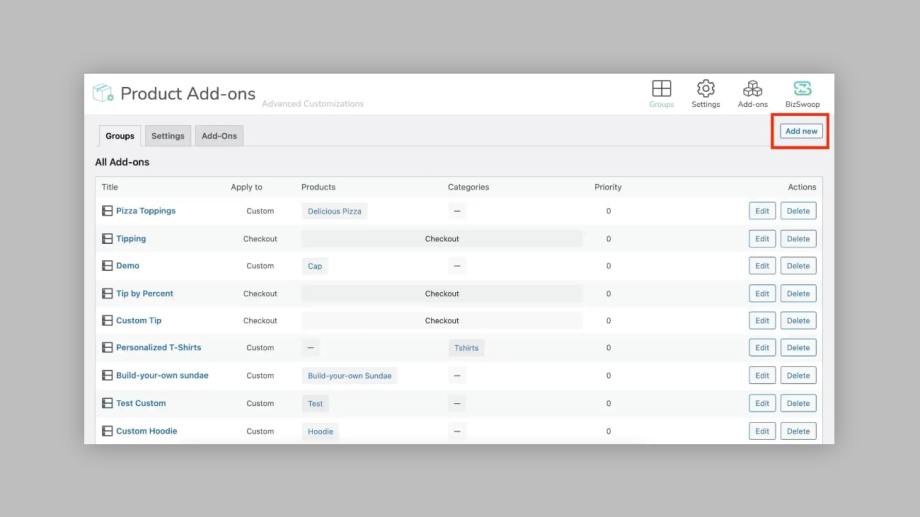
- Fill in the ‘Group name’ field and click on the ‘Apply to’ dropdown to select where the group will apply (e.g., all products, custom products/categories, cart, checkout, or cart and checkout).

- Next to ‘Add-ons’, click ‘Add row’ to create a new add-on to configure. From the ‘Add-on’ dropdown, select the type of input field that the add-on will use.
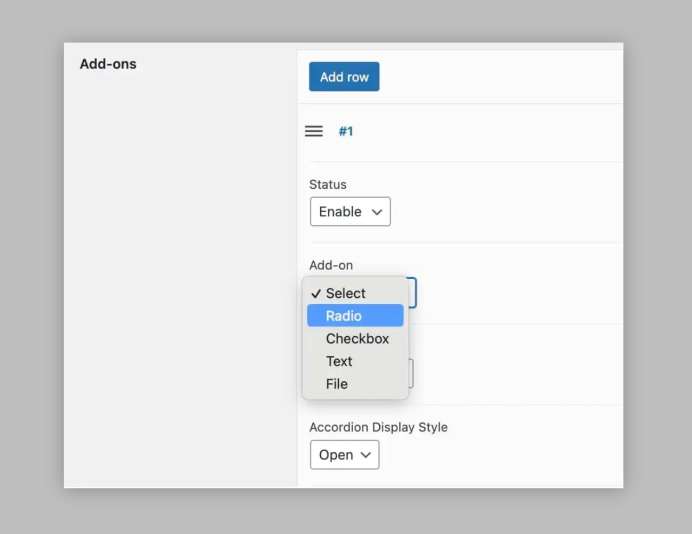
- Select the type of pricing that you want to apply to the add-on. Either apply flat-rate pricing or percentage-based pricing to the product or percentage-based pricing to the subtotal.
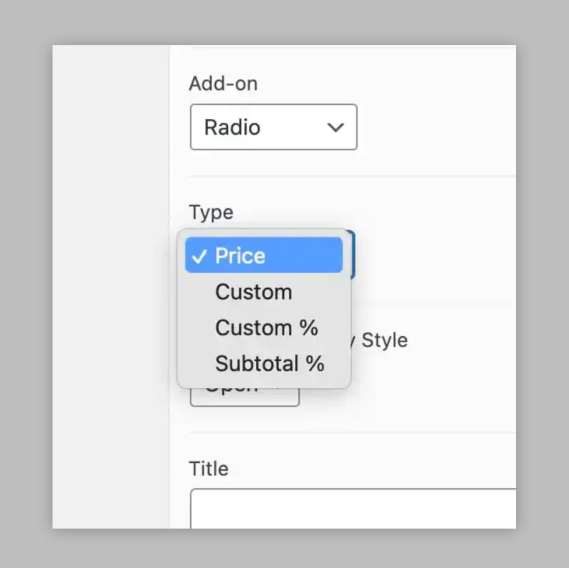
- Add an add-on title and description. Under the description field, check a box to select your description display option (always show, display on mouse hover, or hide).
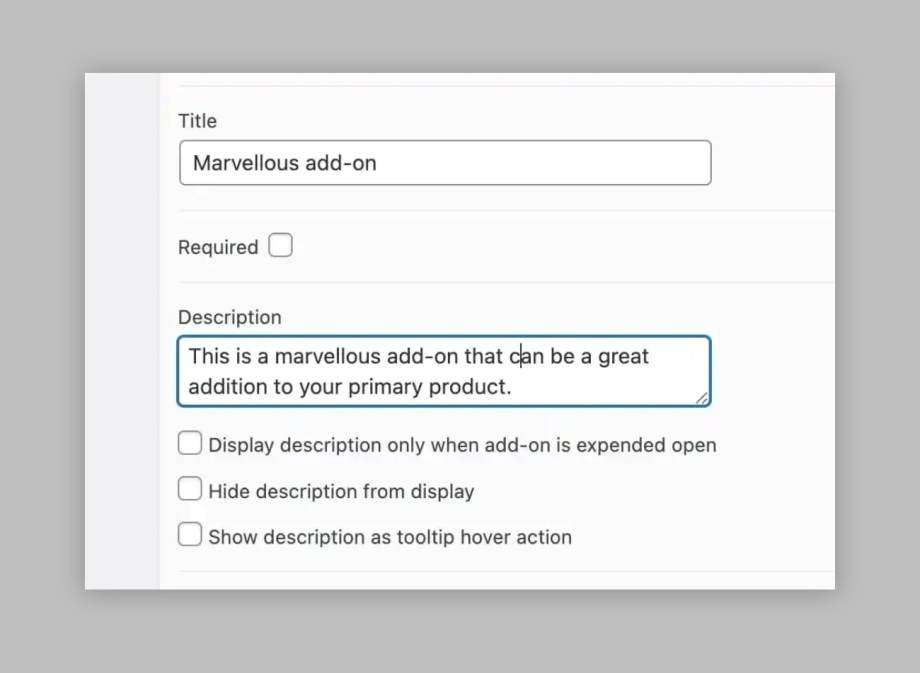
- Click ‘Add option’ to add new choices to your add-on.
- Add a name, an SKU, and a price for your new option.
- Add a description and choose whether to show/hide the description from the display.
- Enable/disable the ‘Allow Multiple Quantity’ dropdown to enable/restrict customers from adding multiple copies of an add-on to their product.
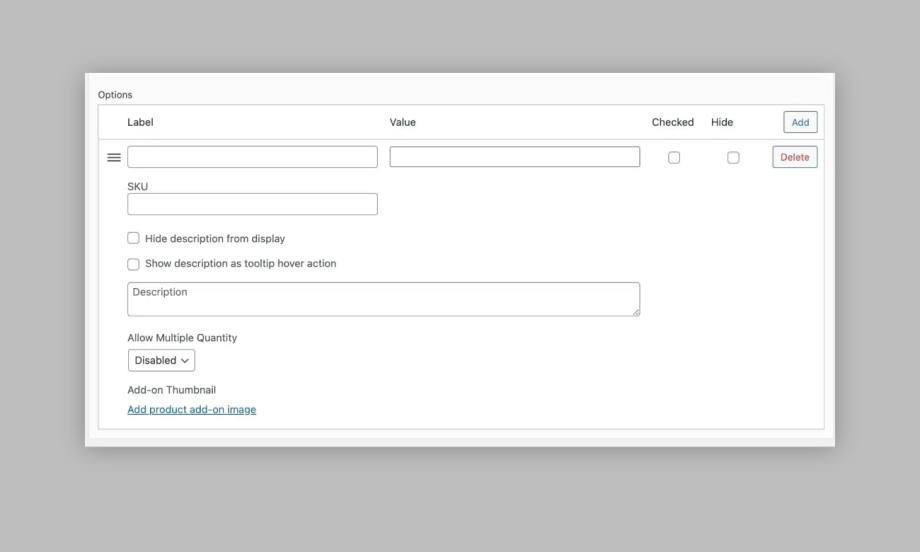
- Add a thumbnail image to provide a visual display of what the add-on looks like.
- Repeat the process to add as many add-ons and options as you like.
- Test the display of your add-on selection on the front end of your WooCommerce store and make any changes that are needed.
And, voila! You have created a range of product variations that the customer can customize from the front end as per their requirements. Product Manager Add-ons makes this process extremely easy and straightforward, to help you get your store set up in no time!
Unleash the power of customization in your WooCommerce store
The digital marketplace is a bustling arena, teeming with competition. As a WooCommerce store owner, integrating product customization is not just an option – it’s an essential ingredient to stand out and cater to evolving consumer demands.
Offering customizable products on your WooCommerce store paves the way for enhanced customer engagement, loyalty, and an intimate connection with your brand. This customization goes hand-in-hand with increased sales, reduced churn rates, and a treasure trove of insights into customer behavior.
With the Product Manager Add-ons for WooCommerce plugin, you have the power to offer flexibility and rich customization options at various stages of the customer journey, significantly elevating the user experience. The best part? The Product Manager Add-ons plugin comes with a 14-day money-back guarantee, offering you a risk-free opportunity to transform your store.
So, why not get started today and unleash the power of customization in your WooCommerce store? Add Product Manager Add-ons to your store and craft a shopping experience that resonates with your customers.
If you need help integrating Product Manager Add-ons with your WooCommerce store, connect with us today!
